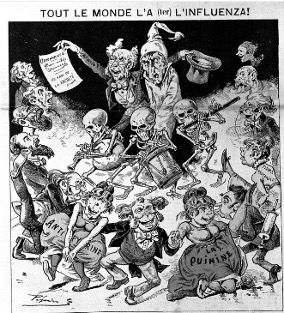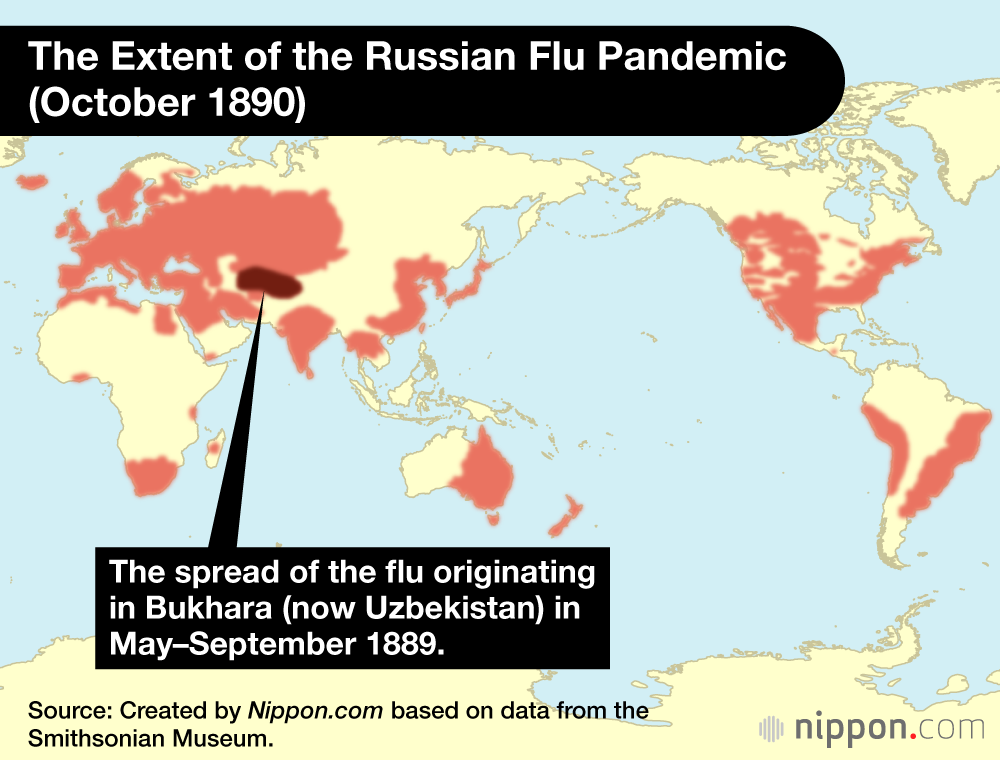Russian Flu: Juggernaut of the 1890s | Nippon.com - Nippon.com
The COVID-19 pandemic shares similarities with the 1889 Russian flu pandemic that spread around the world like wildfire, spreading at some 300 kilometers per week. The Russian flu claimed an estimated 1 million lives out of a total global population of 1.5 billion.
Spreading Like Wildfire
According to European records, the Russian flu pandemic, which originated in the Russian city of Bukhara (now part of Uzbekistan), spread to 33 cities across Europe between the time of the initial November 1889 outbreak and February 1890. In the space of just six weeks, the infection had spread from Stuttgart to Berlin, Vienna, and Switzerland, and on to Amsterdam, Copenhagen, Brussels, and Prague. The virus then headed south to Lyon, Lisbon, and Rome, even reaching Corsica and other Aegean regions. In Madrid, the daily death toll peaked at 300.

Before long, the first death had been reported across the Atlantic in Canton, Massachusetts. This was followed by more reports of cases from Boston and New York in December 1889, and then reports from Chicago, Detroit, Denver, Los Angeles, and San Francisco as the virus travelled down railway lines. Other cities also reported many cases, and total cases peaked on January 12, 1890. Most of those infected complained of severe pneumonia, with a total of 13,000 fatalities across the United States. The indigenous peoples of North America were particularly hard hit.
From Mexico, the virus then spread to Central and South America, finally reaching Buenos Aires on February 2, 1890. The virus continued to spark outbreaks in far-flung locations, including a mass outbreak in Durban, South Africa, in November 1889, before spreading to port cities around the world between late December and January. The wave of infection spread to Australia and New Zealand, and even to Greenland and Iceland.
300 Kilometers per Week
On January 6, 1890, The Times was the first British newspaper to report on the outbreak, which it referred to as the "Russian flu," a name that stuck. Following newspaper articles from the time, we see that the British death toll had reached 110,000 by the end of 1892. The most famous victim was Queen Victoria's grandson Prince Albert Victor, who became infected at a party to celebrate the New Year and developed serious pneumonia, dying five days later at the age of 28. The Duke of Clarence, who was second in line to the throne, also died after his pneumonia symptoms worsened. British Prime Minister Archibald Primrose (the fifth Earl of Rosebery) was infected that year as well, and while Primrose survived, according to newspaper reports he was rendered immobile by severe fatigue.
In the UK, the mortality rate per million population jumped from 146 in 1890 to 544 in 1891. To give you an idea just how serious this is, in 2021 Japan's COVID-19 mortality rate per million population was around 120.
In 1890, Winston Churchill (1874–1965) was a 15-year-old student at Harrow. As the Russian flu broke out in schools and in towns in Sheffield and other parts of the North, its high mortality rate caused panic. In his poem "The Influenza," Churchill expressed fear at the fact that that "The rich, the poor, the high, the low . . . Alike before it droop."
Denmark also experienced a nightmare situation that began when a Russian cargo ship arrived in Copenhagen from Saint Petersburg in December 1989. Immediately after the ship had berthed, the Russian captain was hospitalized with a high-grade fever, and a few days later six soldiers in Copenhagen's barracks had fallen ill. The disease immediately spread to other barracks around the city, resulting in around 20 soldiers being admitted to garrison hospitals every day.
The virus roared throughout Denmark like wildfire, with one record from December 14 stating that around 3,500 people had been infected in Copenhagen alone. It took two years for the virus to rage through the rest of the country, with estimates made at the time putting the infection rate at 75%. The third wave of infection—the result of a mutant strain—was particularly voracious, and was responsible for the highest number of deaths.
In Asia, outbreaks were recorded in India in February 1890, Singapore and the Dutch East Indies (now Indonesia) in March, and China in May. The virus continued to spread throughout the southern hemisphere, from Asia to Australia and New Zealand, and ultimately circumnavigated the globe and arrived back at its origins in Central Asia.
The Russian flu virus spread extremely fast: in fact, estimates put the average speed of travel at 300 kilometers per week, meaning it went around the world in just four months. Despite the fact that the global population was younger then than it is now, the virus claimed a great many victims, causing an estimated 1 million fatalities out of a global population of 1.5 billion. Some researchers believe that the actual death toll was many times higher.

After first appearing in Bukhara, the Russian flu roared around the globe.
Edo Superstitions
While the virus reached Japan in 1890 via India and Southeast Asia, information on deaths is sketchy in the absence of detailed records. However, based on death statistics from Tokyo and Kanagawa Prefectures, chief researcher at the National Institute of Public Health Ōmi Ken'ichi says he believes that there was an abnormal increase in deaths between 1889 and 1891. According to Ōmi, "while the pandemic claimed a lower death toll than the Spanish Flu epidemic of 1918 to 1920 [which claimed around 380,000 lives], in the Kantō region, no other outbreak matched or approached the Russian flu."
Excess mortality is a measure of the extent to which the actual mortality rate exceeds the rate that would normally be expected. In other words, it is a measure of hidden deaths. In addition to infectious diseases, excess mortality can be caused by extreme weather, famine, war, and other unforeseen events.
COVID-19 is another pandemic that has caused an uptick in excess mortality. A research team from the University of Washington recently published an article in the Lancet that estimated excess mortality rates in 74 countries and regions between January 2020 and December 2021. The team article estimates excess mortality in Japan at 111,000, a number six times greater than Japan's confirmed COVID-19 death toll of 18,400. In fact, Japan's estimated excess mortality was higher than that of any of the other 38 OECD member states. Experts have expressed skepticism about this estimate, however, which they say is too high.
According to a study by the National Institute of Infectious Diseases, Japan experienced a record 46,000 excess deaths from January to June 2022. While many believe these were the result of COVID-19, the number of confirmed COVID deaths for the period stands at 12,000. The significant disparity between excess mortality and confirmed COVID deaths suggests that the government was not aware of all COVID cases and that healthcare services were not reaching the entirety of the population.
While the NIID attributes Japan's high excess mortality to stress on the healthcare system, that alone does not explain the over 30,000 excess deaths are not attributed to COVID. The peak in excess mortality coincides with the peak in the administration of the booster shot, and it is believed that other than deaths caused directly by COVID-19, the greatest cause of the increase in excess mortality was the fact that strain on the healthcare system prevented many patients from accessing medical services, as elderly patients unable to leave their homes saw their health conditions deteriorate. Vaccine sceptics, on the other hand, put the deaths down to vaccine side-effects.
In his collection of essays entitled Omoidegusa, novelist Okamoto Kidō (1872–1939), who is known for his work Hanshichi torimonochō (trans. The Curious Casebook of Inspector Hanshichi), describes Tokyo's Kōjimachi district during the Russian flu pandemic.
"This disease first broke out in Japan in the winter of 1890, and became an increasing menace through to the spring of 1891. This was the first we had heard of influenza, which was rumored to have been imported to Yokohama on a ship from France. At the time, however, the disease was generally referred to as osomekaze rather than influenza. . . . Tokyoites took to pasting notes that read Hisamatsu rusu, or 'Hisamatsu is out,' to the eaves of their houses."

A sign reading Hisamatsu rusu (Hisamatsu is out) on the eaves of a house. (Courtesy of the Kōtō City Fukagawa Edo Museum)
But why did the people of the time refer to the disease as osomekaze? The answer: The name was taken from "Osome," the name of the protagonist of a play that was a staple of kabuki and puppet theaters in the day. The play, which concerns a lovers' suicide between Osome, the daughter of an oil seller from Kawarayabashi (Osaka), and Hisamatsu, has been performed many times since its first performance in 1813. In areas of Tokyo affected by the Russian flu, residents are said to have pasted notes that read Hisamatsu rusu, or "Hisamatsu is out," on the eaves of their houses. By telling Osome that she couldn't see her lover because he was unavailable, residents hoped the osomekaze would not come in. While Japan had entered the Meiji era by this time, the way people joked about a deadly disease gives you get a feel for the cheeky Edoite character.
Incidentally, in Japan in that time, influenza epidemics were all named after characters who featured in kabuki. For example, oshichikaze was named after the arsonist Yaoya Oshichi. Infections were also given names like Ryūkyūkaze and Amerikakaze after the Ryūkyū islands and America, the places where they were believed to have originated.
Interestingly, in Japan, January 9 is celebrated as "cold day" due to the fact that sumō wrestler Tanikaze Kajinosuke, who had an unbeaten record in the late 1700s, died of influenza on this day despite being in his prime. In this era, colds were referred to as tanikaze in memory of this mighty sumō wrestler who turned out to be no match for his illness.
(Originally published in Japanese. Banner photo: A socially distanced audience watches an outdoor opera performance at Konzerthaus Berlin in June 2021. © Christian Ender/Getty Images.)
Comments
Post a Comment